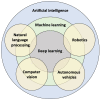Current Applications of Deep Learning and Radiomics on CT and CBCT for Maxillofacial Diseases
- PMID: 36611402
- PMCID: PMC9818323
- DOI: 10.3390/diagnostics13010110
Current Applications of Deep Learning and Radiomics on CT and CBCT for Maxillofacial Diseases
Abstract
The increasing use of computed tomography (CT) and cone beam computed tomography (CBCT) in oral and maxillofacial imaging has driven the development of deep learning and radiomics applications to assist clinicians in early diagnosis, accurate prognosis prediction, and efficient treatment planning of maxillofacial diseases. This narrative review aimed to provide an up-to-date overview of the current applications of deep learning and radiomics on CT and CBCT for the diagnosis and management of maxillofacial diseases. Based on current evidence, a wide range of deep learning models on CT/CBCT images have been developed for automatic diagnosis, segmentation, and classification of jaw cysts and tumors, cervical lymph node metastasis, salivary gland diseases, temporomandibular (TMJ) disorders, maxillary sinus pathologies, mandibular fractures, and dentomaxillofacial deformities, while CT-/CBCT-derived radiomics applications mainly focused on occult lymph node metastasis in patients with oral cancer, malignant salivary gland tumors, and TMJ osteoarthritis. Most of these models showed high performance, and some of them even outperformed human experts. The models with performance on par with human experts have the potential to serve as clinically practicable tools to achieve the earliest possible diagnosis and treatment, leading to a more precise and personalized approach for the management of maxillofacial diseases. Challenges and issues, including the lack of the generalizability and explainability of deep learning models and the uncertainty in the reproducibility and stability of radiomic features, should be overcome to gain the trust of patients, providers, and healthcare organizers for daily clinical use of these models.
Keywords: artificial intelligence; computed tomography; cone-beam computed tomography; deep learning; maxillofacial diseases; radiomics.
Conflict of interest statement
The authors declare no conflict of interest.
Figures



References
-
- Stone P., Brooks R., Brynjolfsson E., Calo R., Etzioni O., Hager G., Hirschberg J., Kalyanakrishnan S., Kamar E., Kraus S., et al. Artificial Intelligence and Life in 2030. One Hundred Year Study on Artificial Intelligence: Report of the 2015–2016 Study Panel. Stanford University; Stanford, CA, USA: 2016. [(accessed on 5 December 2022)]. Available online: http://ai100stanfordedu/2016-report.
Publication types
LinkOut - more resources
Full Text Sources

